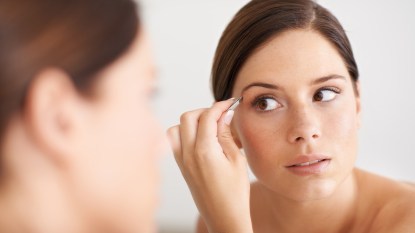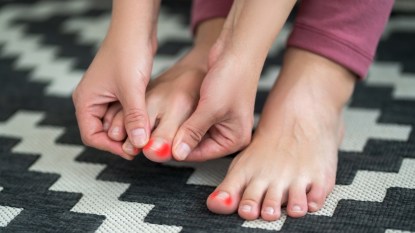Study: The Fragrance of Sandalwood Essential Oil Activates Your Hair Follicles To Grow Longer, Thicker Hair
Dermatologists: How to use the oil to regrow thinning hair, reverse sun-damage to skin and more
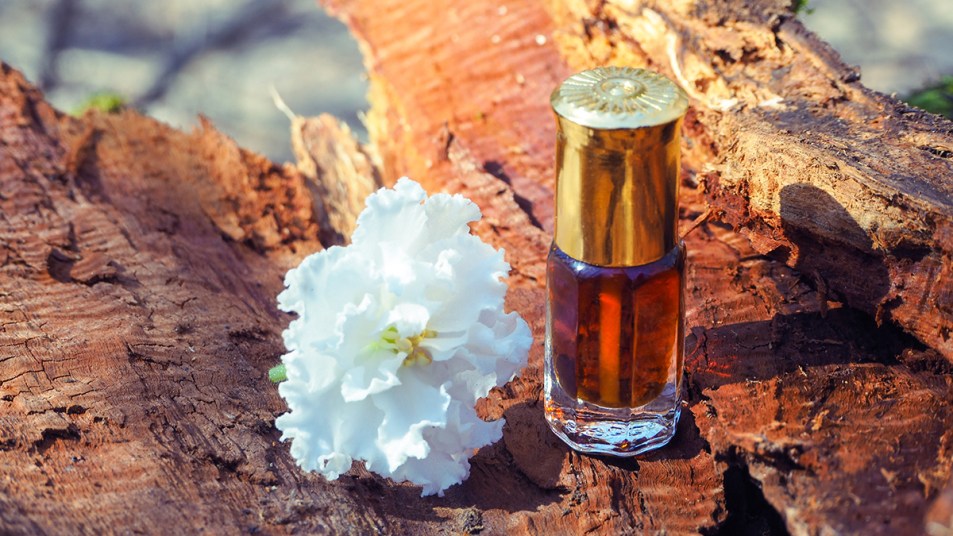
While it’s long been used as a beauty tonic across cultures, particularly in Ayurvedic and traditional Chinese medicine, you may have noticed sandalwood essential oil increasingly showing up in hair and skin treatments and perfumes in recent years. And that’s because in the world of essential oils, sandalwood essential oil (and Sandalore, a synthetic version of the oil) stands out for its study-proven anti-aging effects which include both regrowing hair and fighting skin aging. Read on to learn more about how sandalwood essential oil benefits you.
How sandalwood oil beautifies skin and hair
There’s quite a bit of evidence that sandalwood essential oil does, in fact, have a bevy of beauty benefits including anti-inflammatory, anti-bacterial, moisturizing and aromatherapeutic properties making it a great natural ingredient in beauty products.
While it’s used in everything from perfume and hair products, its most major impacts on the hair and skin have been proven by clinical studies. One, explains, Dr. Geeta Yadav, MD, board-certified dermatologist and founder of FACET Dermatology, “is that it has free radical defense and protection against skin breakdown as well as antimicrobial properties.” Meaning sandlewood can help hold off fine lines and even help repair and protect more mature skin. And, two, according to two separate studies using a synthetic version of the oil (that’s used in haircare products) it has the ability to help regrow thinning hair.
A third bonus? The oil’s scent has mood-boosting properties, explains celebrity aesthetician and holistic healer and practitioner Tammy Fender, which is just another reason why she puts it at the cornerstone of her professional spa treatments.
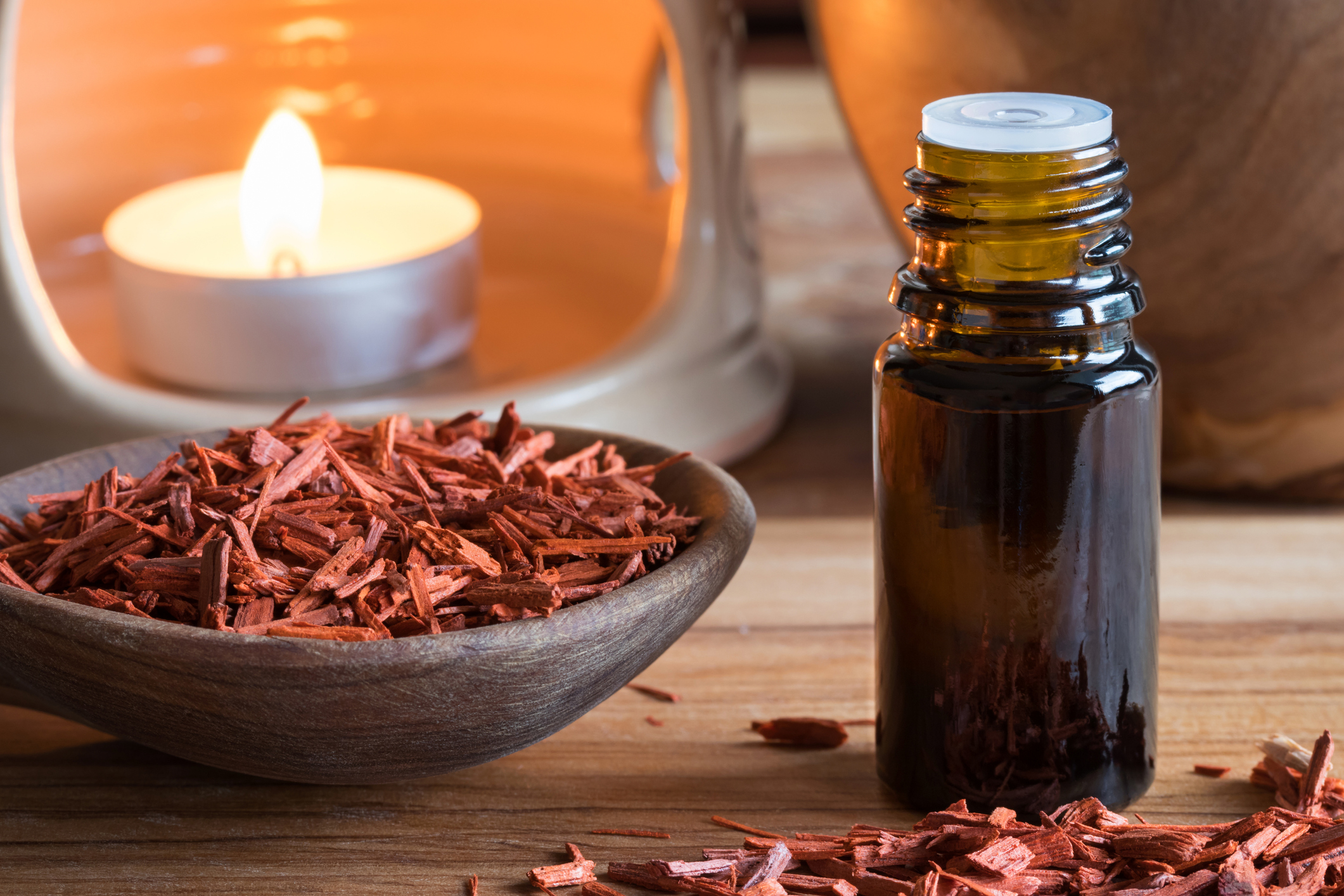
If you want to get on board the sandalwood beauty train, here’s what you can expect from adding it into your routine — and what to know about using it safely and effectively.
How sandalwood oil regrows hair
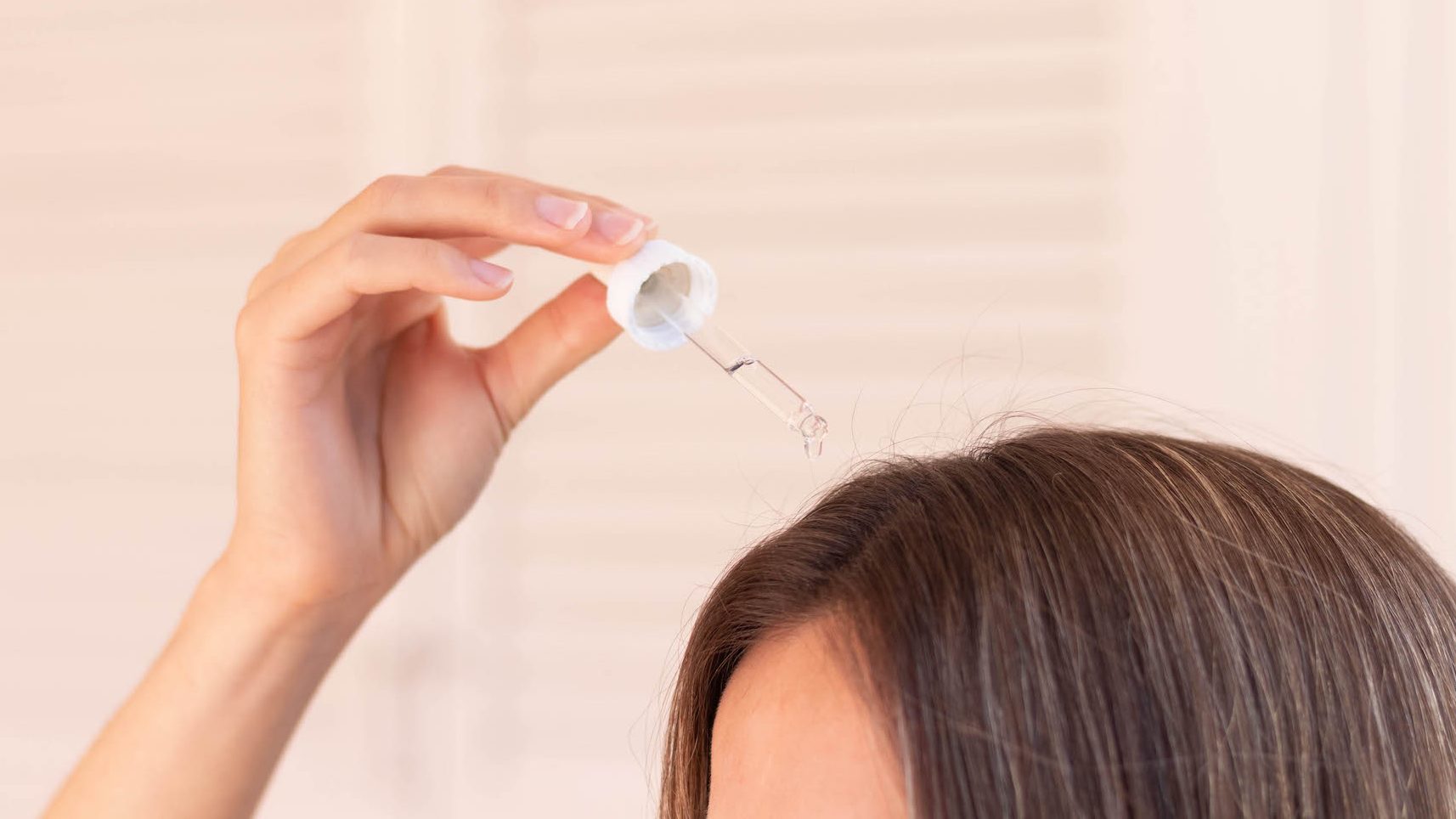
Notice more shedding, some sparse spots or just overall thinning? A synthetic version of sandalwood has been proven to help reverse this hair loss.
Turns out that our hair follicles can smell, and a study published in the Journal of Cosmetic Dermatology, found that olfactory receptors in the scalp reacted to the scent of Sandalore, a synthetic form of sandalwood. In fact, subjects who were exposed to Sandalore experienced a significant reduction in hair shedding and increased hair volume in 24 weeks. How it works? Hair follicles express an olfactory receptor of their own and when it comes into contact with the molecular structure of the synthetic sandalwood scent, it stimulates hair growth.
Also great? One German study published in the journal Nature Communications found that using Sandalore topically helps keep hair in the growth phase while boosting growth-encouraging hormones by 30% in just six days.
What’s more, the musky scent lowers blood pressure for added relaxation.
To reap the benefits:
- Opt for a hair-growth serum that contains Sandalore, such as Nioxin Ultimate Power Serum (Buy from Amazon. $50). This treatment also contains caffeine, lauric acid and niacinamid, all ingredients known to help make hair thicker — in fact, 93% of users noticed less hair in their brush after the first use.
- Give your scalp a sandalwood massage: Mix 10 drops of sandalwood oil, like Sandalwood Essential Oil, 100% Pure Natural Aromatherapy Sandalwood Oil (Buy from Amazon, $7.95) with 2 Tbs. of a carrier oil like olive oil and apply all over damp hair; rinse after 15 minutes.
How sandalwood oil prevents skin aging
Whether you have wrinkles, age spots or dull, dehydrated skin, sandalwood oil can help! Sandalwood oil, particularly Indian sandalwood oil called santalum album, has been found to have antioxidant properties. In fact, a study published in the journal Antioxidants in 2021 evaluated the antioxidant potential of Indian sandalwood essential oil and found that it exhibited significant antioxidant activity.
This is key, especially for aging skin. As Dr. Yadav explains, “Antioxidants defend your skin from oxidative damage caused by free radicals, which can come from everything from pollution and cigarette smoke to blue light and UV exposure. By protecting your skin with antioxidants, you are helping to inhibit that oxidative stress, which can manifest as fine lines and wrinkles, skin laxity, hyperpigmentation and other common skin concerns.”
And as a bonus, the oil also acts as an emollient. David Petrillo, cosmetic chemist and founder of Perfect Image explains: “The oil is known for its moisturizing properties, which can help keep the skin hydrated and prevent dryness. It is often used to nourish and improve the skin’s texture.” And moisturized skin look less wrinkled and dull and more supple and dewy.
To reap the benefits:
Try this DIY Royal Hawaiian Sandalwood Facial Toner recipe by Ed Dailey, Director of Product Education with Young living Essential Oils: In a 2 oz. glass container, combine 5 drops essential oil, like Royal Hawaiian Sandalwood Hydrosol (Buy from Young Living, $14) and 1/2 tsp Vitamin E oil and top off with a few drops of scentless, alcohol-free witch hazel. Swipe on your face after cleansing and before moisturizer once a day.
More benefits of using sandalwood essential oil
Sandalwood oil can soothe rashy skin
Sandalwood essential oil has been proven to have anti-inflammatory properties that may help with the treatment of conditions like eczema and psoriasis and can calm finicky skin in general, says Petrillo. “It can help soothe irritated skin and reduce redness.” Plus, one 2018 study found that a combination of sandalwood and honey helped reduce the risk of scarring.
To reap the benefits:
Try this recipe from Adriana Ayales, clinical herbalist and founder & CEO of Anima Mundi:
Mix 1 oz. of jojoba oil with several drops of sandalwood oil and shake well. Apply sparingly to areas that need soothing or use a Gua Sha tool like AMETHYST GUA SHA, Hand Carved (Buy From Anima Mundi, $19.90) to activate microcirculation and blood flow.
Sandalwood oil can prevent breakouts
“Sandalwood oil has astringent properties, which means it can help tighten and tone the skin. It is often used in oily or combination skin products to help control excess oil production and minimize the appearance of pores,” says Petrillo. “It also has natural antibacterial and antifungal properties, making it effective in combating bacteria and fungi that can cause skin infections and breakouts.”
One study in the Journal of Drugs in Dermatology found that it serves as an especially good assistant to salicylic acid. “That’s because its antibacterial properties can help reduce growth of acne-causing bacteria while its anti-inflammatory properties can reduce the inflammation that exacerbates blemishes and makes them more painful,” says Dr. Yadav, “That’s why these two ingredients look like a promising combination!”
To reap the benefits:
Essential oil expert Roxy Saran recommends adding a 1 drop of sandalwood oil and 1 drop of soothing lavender to your favorite facial moisturizer. Apply onto clean skin.
Sandalwood oil can help relax you
Sandalwood fans know its rich, earthy scent is intoxicating — and that’s why it’s a favorite among perfumers. Petrillo says it’s often added to products for its aromatherapeutic effects as well. “The soothing oil can help reduce stress and promote a sense of calmness.” Science shows this to be true too, as animal studies suggest it has a relaxing effect on the nervous system. (Click through for more easy ways to regulate your nervous system and to discover the best essential oils for congestion.)
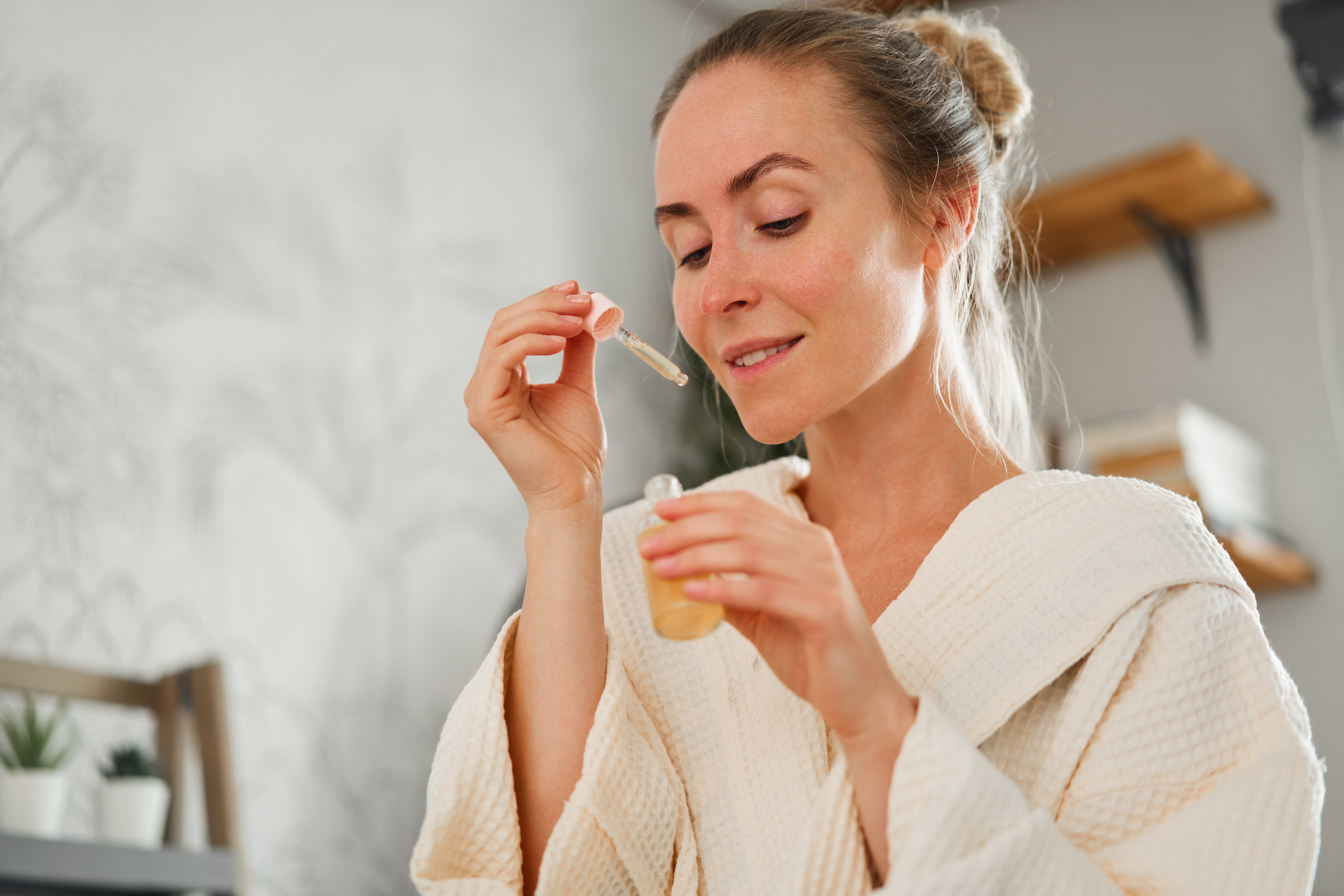
What to know when and how to use sandalwood oil
If you’re planning to make your own recipes as noted above, Dr. Yadav says it’s important to dilute the oil with a neutral carrier oil like jojoba or sweet almond oil.
And make sure to patch-test it before using to ensure you don’t have an adverse reaction.
Petrillo’s how-to: “Apply a diluted drop of the oil mixture on the inside of your wrist or elbow and wait 24 hours to check for any adverse reactions like redness, itching or irritation.” If irritation occurs, avoid using it. If you get the go-ahead to use it, he stresses to avoid sensitive areas such as the neck and genitals area and to avoid sun exposure 24 hours after to avoid irritation.
Watch this video to learn other ways you can use sandalwood essential oil to reverse aging:
Another way to reduce the possibilities of ending up with redness or a rash is to find the oil in ready-made formulas where cosmetic chemists have done all the work of finding the right percentages and quality of ingredients.
For example, you can find sandalwood oil in:
Clarins Santal Soothing & Hydrating Natural Face Treatment Oil (Buy from Bloomingdale’s, $65)
Forest Essentials Night Treatment Cream Sandalwood & Saffron (Buy from Amazon, $52.50)
Love Beauty and Planet Moisturizing Daily Shampoo with Coconut & Australian Sandalwood Oil (Buy from Walmart, $10.10).
And to get in on the aromatherapeutic benefits, you can try fragrances like:
CK EVERYONE by Calvin Klein (Buy from Amazon, $70) and Promise by Jennifer Lopez (Buy from Amazon, $44.99).
To learn more about the beauty benefits of essential oils:
Add These Essential Oils to Your Shampoo for Thicker, Healthier Hair
5 Ways to Use Essential Oils for Crepey Skin, Age Spots and More
This $8 Essential Oil Can Help Relieve Pain and Slow Down Signs of Skin Aging


